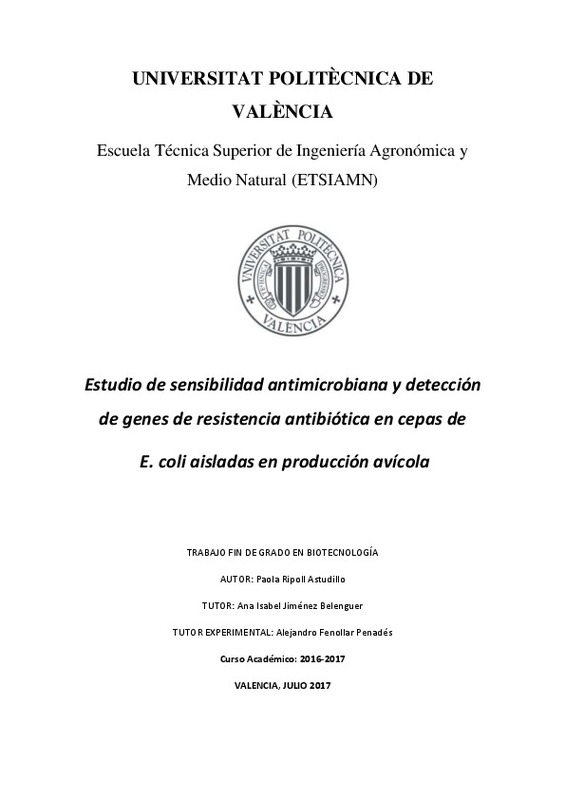|
Resumen:
|
[ES] En las últimas décadas se ha incrementado la preocupación del público por el uso que
se hace de los antibióticos debido a la aparición de cepas resistentes que se han propagado y
que han ido limitando en algunos ...[+]
[ES] En las últimas décadas se ha incrementado la preocupación del público por el uso que
se hace de los antibióticos debido a la aparición de cepas resistentes que se han propagado y
que han ido limitando en algunos casos la efectividad de los antibióticos para tratar infecciones
bacterianas en humanos. El tracto gastrointestinal humano es un reservorio importante de
bacterias con capacidad tanto de recibir como de transferir genes de resistencia, por lo que es
importante tener en cuenta el fenómeno de la transmisión genética horizontal como un riesgo
añadido ya que si los alimentos ingeridos están contaminados con cepas bacterianas
resistentes éstas pueden llegar al consumidor. En el presente trabajo se estudiaron 191 cepas
de E. coli procedentes de gallinas reproductoras, con el objetivo de analizar por un lado la
susceptibilidad a 8 antimicrobianos distintos mediante la técnica disco-placa, y por otro la
detección de genes de resistencia a antibióticos, como son: TEM, SHV, CMY-2, qnrS y ermB. Los
resultados mostraron que el 84,34% de las cepas eran resistentes a al menos uno de los
antibióticos y el 18,85% multirresistentes. Los antibióticos para los que más resistencias
aparecieron fueron: ampicilina, ácido nalidíxico y tetraciclina, y de los 9 patrones encontrados,
NA-AMP-C y NA-AMP-TE fueron los más prevalentes. En el análisis de los genes de resistencia,
el gen TEM, seguido del gen qnrS fueron los que se detectaron en mayor número de cepas y
estos resultados coincidieron con los antibióticos para los que aparecieron más resistencias.
Finalmente, el estudio de resistencias a antibióticos y la utilización de métodos moleculares de
detección de genes de resistencia resultó ser una herramienta eficaz para la caracterización de
resistencias antimicrobianas.
[-]
[EN] In recent years, there has increased public concern about the use of antibiotics due to
the emergence of resistant strains that have been spread and it has been restricting in some
cases the effectiveness of antibiotics ...[+]
[EN] In recent years, there has increased public concern about the use of antibiotics due to
the emergence of resistant strains that have been spread and it has been restricting in some
cases the effectiveness of antibiotics to treat bacterial infections in humans. The human
gastrointestinal tract is an important reservoir of bacteria capable of both receiving and
transferring resistance genes, it is important to consider the phenomenon of horizontal genetic
transmission as an added risk because the food ingested could be contaminated with resistant
bacterial strains. In this work, 191 strains of E. coli from breeding hens were studied, with the
aim of analyzing the susceptibility to 8 different antimicrobials using the disk-plaque technique
and, on the other, the detection of antibiotic resistance genes: TEM , SHV, CMY-2, qnrS and
ermB. The results showed that 84.34% of the strains were resistant to at least one antibiotic
and 18.85% multiresistant. The antibiotics that showed the greatest resistance were:
ampicillin, nalidixic acid and tetracycline, and 9 patterns were found, NA-AMP-C and NA-AMPTE
were the most prevalent. Analysis of the resistance genes showed that the TEM gene
followed by the qnrS gene were detected in higher numbers of strains. These results were in
agreement with the antibiotics more prevalent. Finally, the study of antibiotic resistance and
the use of molecular methods to detect resistance genes proved to be an effective tool for the
characterization of antimicrobial resistance.
[-]
|







